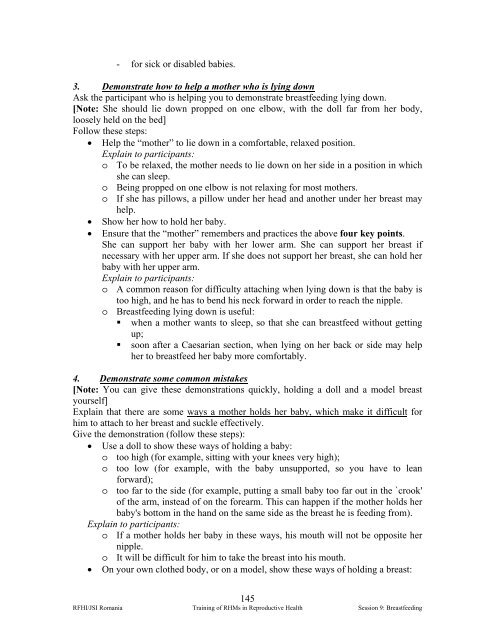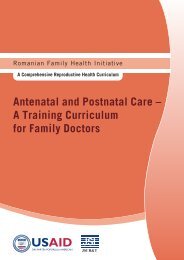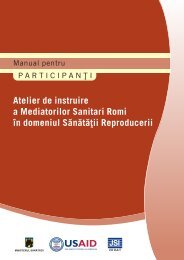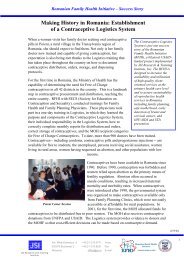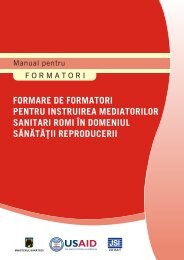Training of Roma Health Mediators in Reproductive Health
Training of Roma Health Mediators in Reproductive Health
Training of Roma Health Mediators in Reproductive Health
You also want an ePaper? Increase the reach of your titles
YUMPU automatically turns print PDFs into web optimized ePapers that Google loves.
- for sick or disabled babies.<br />
3. Demonstrate how to help a mother who is ly<strong>in</strong>g down<br />
Ask the participant who is help<strong>in</strong>g you to demonstrate breastfeed<strong>in</strong>g ly<strong>in</strong>g down.<br />
[Note: She should lie down propped on one elbow, with the doll far from her body,<br />
loosely held on the bed]<br />
Follow these steps:<br />
• Help the “mother” to lie down <strong>in</strong> a comfortable, relaxed position.<br />
Expla<strong>in</strong> to participants:<br />
o To be relaxed, the mother needs to lie down on her side <strong>in</strong> a position <strong>in</strong> which<br />
she can sleep.<br />
o Be<strong>in</strong>g propped on one elbow is not relax<strong>in</strong>g for most mothers.<br />
o If she has pillows, a pillow under her head and another under her breast may<br />
help.<br />
• Show her how to hold her baby.<br />
• Ensure that the “mother” remembers and practices the above four key po<strong>in</strong>ts.<br />
She can support her baby with her lower arm. She can support her breast if<br />
necessary with her upper arm. If she does not support her breast, she can hold her<br />
baby with her upper arm.<br />
Expla<strong>in</strong> to participants:<br />
o A common reason for difficulty attach<strong>in</strong>g when ly<strong>in</strong>g down is that the baby is<br />
too high, and he has to bend his neck forward <strong>in</strong> order to reach the nipple.<br />
o Breastfeed<strong>in</strong>g ly<strong>in</strong>g down is useful:<br />
• when a mother wants to sleep, so that she can breastfeed without gett<strong>in</strong>g<br />
up;<br />
• soon after a Caesarian section, when ly<strong>in</strong>g on her back or side may help<br />
her to breastfeed her baby more comfortably.<br />
4. Demonstrate some common mistakes<br />
[Note: You can give these demonstrations quickly, hold<strong>in</strong>g a doll and a model breast<br />
yourself]<br />
Expla<strong>in</strong> that there are some ways a mother holds her baby, which make it difficult for<br />
him to attach to her breast and suckle effectively.<br />
Give the demonstration (follow these steps):<br />
• Use a doll to show these ways <strong>of</strong> hold<strong>in</strong>g a baby:<br />
o too high (for example, sitt<strong>in</strong>g with your knees very high);<br />
o too low (for example, with the baby unsupported, so you have to lean<br />
forward);<br />
o too far to the side (for example, putt<strong>in</strong>g a small baby too far out <strong>in</strong> the `crook'<br />
<strong>of</strong> the arm, <strong>in</strong>stead <strong>of</strong> on the forearm. This can happen if the mother holds her<br />
baby's bottom <strong>in</strong> the hand on the same side as the breast he is feed<strong>in</strong>g from).<br />
Expla<strong>in</strong> to participants:<br />
o If a mother holds her baby <strong>in</strong> these ways, his mouth will not be opposite her<br />
nipple.<br />
o It will be difficult for him to take the breast <strong>in</strong>to his mouth.<br />
• On your own clothed body, or on a model, show these ways <strong>of</strong> hold<strong>in</strong>g a breast:<br />
145<br />
RFHI/JSI <strong>Roma</strong>nia <strong>Tra<strong>in</strong><strong>in</strong>g</strong> <strong>of</strong> RHMs <strong>in</strong> <strong>Reproductive</strong> <strong>Health</strong> Session 9: Breastfeed<strong>in</strong>g


